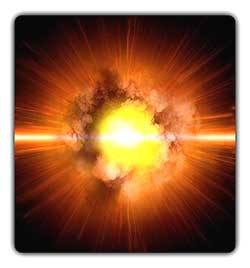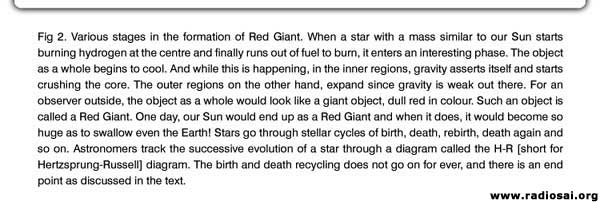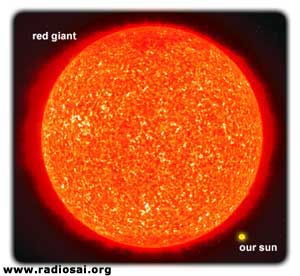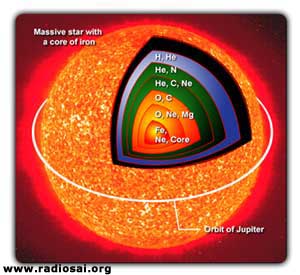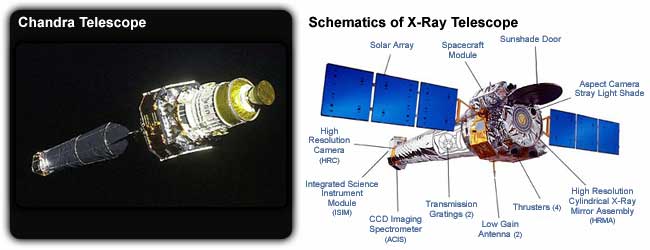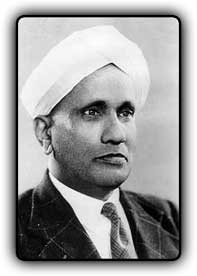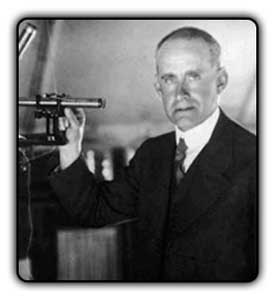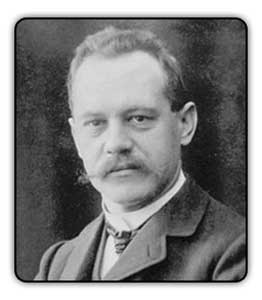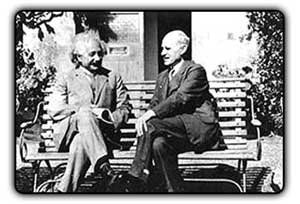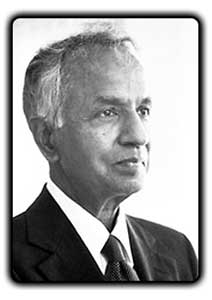 |
 |
 |
Volume
5 - Issue 03 MARCH 2007
|
|
MUSINGS from prasanthi nilayam IN QUEST OF INFINITY - 03 By Prof G. Venkataraman THE BIRTH AND DEATH OF STARS Sai Ram and warm greetings again. I hope you are finding this journey exciting. Last time, I introduced you to some facts relating to the birth of our Universe. Today, I would like to tell you something about the birth and death of stars. Stars may not have life the way we have, but there is such a thing as coming into existence of a star, and the end of life as a star. Believe it or not, like us humans, stars too have rebirth! So, there is a fascinating exploration ahead of us. In The Beginning….
Where humans are concerned, the Bible says it all began with Adam and Eve. In the same way, we must start by discussing how the very first stars in the Universe came into existence. For this purpose, we have to go back to the very beginning of the Universe, namely the so-called Big Bang. I shall skip for the moment the complex sequence of events that took place within the first one second after birth. This first one second is extremely important and incredibly fascinating but for our present purposes, it is better to start after the first one second. So what was the Universe like, when it was a one-second old baby? First about the size. At the age of one second, the Universe had a radius of roughly 10 billion km [or one thousandth of a light year]; for comparison, the distance of Pluto from the Sun is roughly 6 billion km. Today, the size of the Universe is about 15 billion light years. Just to remind you, one light year equals a distance of 10 trillion km; so today, the radius of the Universe is ten trillion times fifteen billion km! That is a real WOW, is it not? And so, at one second, the Universe was really small compared to what it is today. OK, now what was the Universe made up of when it was just one second old? Were there stars, planets, etc? None of these. The Baby Universe was made up of electrons and atomic nuclei, that is to say nuclei of simple elements like hydrogen and a bit of helium, that is all. For the next several thousand years or so, nothing much happened except that the baby kept on growing, and while this expansion took place, the Universe was basically filled with gas of hydrogen and a bit of helium. Of course, the distribution of the gas was not uniform; in some places there was more and in others there was less; even so, it was gas everywhere, though with varying density. Gravity Takes Hold About a million or so years after the birth [by this time the Universe was much bigger] in some places where there was a big concentration of gas, the gas cloud began to shrink. How come? Because of gravity. I suppose you know that gravitational force, discovered by Newton, is an attractive force. Matter attracts matter, and that is what gravity is all about. Now a hydrogen gas cloud is made up of hydrogen atoms and atoms being matter, can attract each other. True, the hydrogen atom is extremely small and therefore its pulling power too is very, very small. And when two atoms are say a million km apart, the attraction may seem nothing to write home about. But this is where Nature stuns us. Thanks to sheer numbers, the little pulls all add up, and eventually the gas cloud behaves as if someone is massively squeezing it from outside. No one really is; what is actually happening is that every atom pulls every other atom and the net result is that all of them start coming closer and closer together. To someone outside, this might seem as if there is a squeeze that is being applied; it is just self-squeeze, operated by gravity. For the record, I should mention that while gravity pulls inwards, the cloud does try to diffuse due to gas pressure like all clouds do. I am sure you have seen fluffy clouds in the sky becoming bigger through diffusion caused by outward gas pressure and then sort of melting away. However, this gas pressure is peanuts and gravity simply overwhelms it. Gravity is really amazing. It appears weak and insignificant but on the scale of the Universe, it calls the shots because its reach is so long! OK, so the big hydrogen cloud is getting squeezed more and more. What happens? Does it get crushed into a point? Not really, because something starts happening when the cloud really begins to shrink. You see, the shrinking process is accompanied by a heating process also, the heating being greatest at the centre of the cloud. Now when I say the cloud is getting hot, do not imagine temperatures like what we experience during a hot summer day. Believe it or not, at the centre of the cloud, the temperature can become as high as a MILLION degrees! WOW!! Now that is some temperature, is it not? Of course it is, and sure enough things start happening. Devices for Thermo-Nuclear Fusion I must clarify that when I say that the temperature in the compressed gas cloud can go as high as a million degrees, what I mean is that it does so at the core of the cloud. As one moves away from the centre, the temperature starts falling. However, the fact that the temperature rises to a million degrees and above near the centre, makes interesting things happen. Basically, the astronomically high temperature makes hydrogen nuclei to fuse together to form the nuclei of helium. I will skip the details, which belong to the realm of nuclear physics; but this I must say – this coming together of hydrogen nuclei to form helium nuclei is called nuclear fusion, and because this fusion of light nuclei to become bigger nuclei is driven by high temperature, it is often called thermo nuclear fusion. The important and interesting thing about this nuclear fusion is that it is accompanied by the release of a lot of energy. This energy then flows outwards towards the outer surface which is cooler – I guess you are aware that heat always flows from a region of high temperature to a region of low temperature. From the surface of the cloud, the energy is radiated into space as heat and light. To repeat, first there is gravitational compression of the hydrogen gas cloud. This leads to heating, especially at the centre. When very high temperatures are attained, there is thermo-nuclear ignition. This is a process where small nuclei fuse to form bigger nuclei, and in the process heat is also released. This process is sustained and a star is born. This sequence of events is schematically illustrated in Fig. 1.
Question: Initially, there was compression that then led to thermo-nuclear ignition. Does compression continue after the ignition is triggered? No! What happens is that while gravity tries to compress the gas cloud, radiation flowing outwards exerts an outward pressure that tries to expand the gas cloud. So there is a tussle between the inward force due to gravity that tries to compress the gas cloud and the outward force due to radiation [that is substantial] that tries to expand the gas cloud. A balance is reached, then we then have a gas cloud of stable size that is hot at the centre and radiates energy into space. So that is how a star is born out of a gas cloud that is large and cold to start with. By the way, in a hydrogen bomb, enormous energy is released via thermo-nuclear fusion. However, in the bomb, it is all over in less than a millionth of a second, whereas a star keeps releasing thermo-nuclear energy for millions if not billions of years. Our Sun is thus nothing but a self-sustaining thermo-nuclear device! OK, a star is born. Will it burn forever or does it have a finite life? If the latter is indeed the case, then how long does a star live? The answer to that is simple. A star is like a burning fire; just as a log of wood would burn as long as there is some wood left, so also a star would burn as long as there is fuel. When the fuel supply starts running down, the temperature starts coming down and cooling starts. Then a whole new ball game starts. That story next. The Stellar Cycle: Birth, Death and Rebirth I said that when the fuel gets exhausted, burning or thermo-nuclear ignition stops and the star starts cooling down. Two things happen then. First in the inner regions of the burnt out star, where density is high, gravity begins to dominate and a contraction process sets in. The outer layers on the other hand try to diffuse away like a cloud. So the net result is that the cloud as a whole appears very large from the outside; however, the inner region starts contracting and getting hot once again. By the way, when our Sun “dies” and starts expanding, it is expected to become so large as to extend all the way close to Earth; it would become a real giant with a dull red glow when seen from outside. See Fig. 2. Astronomers have detected many red giants, and that is why the hypothesis is believable.
OK, so we have this red giant, large and thin on the outside but the core contracting and getting hot again. What happens next? That is an interesting story. You see, in the first generation stars, hydrogen nuclei fused to form helium nuclei and when the supply of hydrogen runs down, thermo-nuclear burning stops.
That is when the star becomes a red giant with the core again contracting and getting hot. Any likelihood of ignition? Yes there is, and this time the temperature must rise to a level where helium can act as the fuel. So you see, in the first attempt, the star is a cauldron in which hydrogen is converted into helium. After a “rest” period it starts all over again, with the same sort of story repeating. First there is a contraction due to the influence of gravity, then the core heats, and when the temperature is right, there is thermo-nuclear ignition once more, this time helium nuclei fusing to make up a slightly heavier nucleus, releasing energy in the process. This energy flows outwards and is finally radiated into space. This is the daughter star so to speak. From the daughter is born another star, the grand-daughter so to speak, and so on it goes, generation after generation. In short, a star is born, it burns, dies, is reborn, dies, is reborn, dies and so on. Every time the star becomes a cauldron where elements get cooked, light elements get fused into heavier elements, and in this way, newer and newer elements [see Fig. 3] that chemistry students learn about came into existence in the Universe.
Discovering What Happens Next Any end to this process of stars being born, dying, being born again, etc? Yes there is, and that is when the core, after having evolved through many stages is substantially made of iron. Thereafter, thermo-nuclear ignition with continuous release of energy is ruled out by the laws of nuclear physics, and the birth-death-rebirth process stops - there is no more chance of heavier elements being formed through stellar cycles.
You might wonder: “But on earth we find silver, gold, uranium etc., all of which are much heavier than the iron nucleus; where from did they come?" That is a very interesting question to which we shall return may be in the next issue. By the way, I hope you would have noticed how nuclear physics is helping astrophysics. All this understanding of stellar physics through the injection of nuclear physics that I am now describing started happening in the period between 1930 and 1940. This is one remarkable aspect of the development of modern physics. Different specialisations often come together in an amazing and unexpected way to push forward the frontiers of knowledge. Thus far, what I have told you is the following: For the first million years or so, there were no stars. Thereafter, the first stars were born. They lived for some time and stopped burning fuel inside when the supply of hydrogen became small. After a “rest” period, another sequence of burning started, this time helium [produced in the first generation stars] acting as the fuel. After helium is burnt out, there is again a rest period, and a rebirth in which helium becomes a slightly heavier element and so on, it is punarapi jananam stuff playing out here in the Cosmos! Question: “What happens to a star when it finally ceases to burn?” This is exactly where the story becomes even more interesting! The Prodigious Subramanyan ChandrasekharThat story is connected with a famous scientist who started it all when he was a mere eighteen-year old college student. His name is S. Chandrasekhar. He later became a world famous scientist, and won the Nobel Prize too. But as someone said, he did not become great with the Prize; already he was so renowned that it was the Nobel Prize that gained in prestige by getting awarded to him. There is, by the way, a NASA satellite carrying an x-ray observatory in space named CHANDRA, launched in 1996, that has provided spectacular images and insight into stellar physics.
The story of the discovery that young Chandra made goes as follows. In the late twenties of the twentieth century, Chandra was a Physics Honours student in Presidency College in Madras. His uncle, Sir. C.V. Raman, who had studied earlier in the same college, had become world famous with his discovery of the Raman Effect for which he won the Nobel Prize in 1930. Chandra was clearly out of the ordinary, and even when he was a student, he had already published a scientific paper, unusual in India then, and indeed even now.
Chandra was totally focussed on physics and received as a prize a book entitled The Internal Constitution of Stars, written by the famous English astrophysicist, Arthur Eddington. The best way of describing Eddington’s stature would be to say that he was then the David Beckham of astrophysics! This book made a deep impact on young Chandra and got him to think intensely about stars and problems in astrophysics. That was when an event happened that was to change his life.
On Raman’s invitation, a famous German Physicist named Arnold Sommerfeld, who was a master teacher and who nursed nearly half a dozen Nobel winners [!] in Munich, was visiting India in 1928, and giving lectures in various places. One of his stopovers was Madras, and there in the Presidency College, Sommerfeld gave a lecture on the newly emerging quantum physics and its implications. Chandra of course was present in the audience, but one wonders whether anyone in the audience, Chandra being the exception, followed what Sommerfeld spoke about. Leaving for Cambridge After the lecture, Chandra who was then thinking a lot about stars had a meeting with Sommerfeld and asked him many questions. There was one particular problem that preoccupied him most and when, after studies were over, his father asked him to appear for a competitive examination that would qualify him for a big government job, Chandra flatly refused – thank God he did! Instead, he headed for Cambridge, then the Mecca of Physics. And Cambridge, by the way, was where Eddington was at that time. The year was 1930. In those days, there were no jet planes, and one had to travel to England by ship. The journey took about two weeks, and to keep passengers engaged, the Captain of the ship usually organised all kinds of games and parties. Young Chandra, however, kept himself busy thinking about what happens to stars when they finally end their lives. Now there are a class of astro-objects known as White Dwarfs. They are supposed to be dead stars, that is, stars where thermo-nuclear ignition has totally ceased; in other words, a White Dwarf is really a stellar corpse. Chandra was interested in the physics of White Dwarfs. The interesting thing about a White Dwarf is that matter there is very dense. You want to know how dense? Imagine taking a small piece of material from the White Dwarf, about the size of a tennis ball. That small piece would weigh as much as 25 elephants! That is some density, is it not? See Fig. 4.
What Chandra did on board was to think hard about the physics of White Dwarfs, and this he did via his favourite way, writing down complex mathematical equations and cracking them. In the process, Chandra made a discovery. It was kind of weird, and Chandra was not too sure. He would have to analyse more carefully, and then check and cross check; all that was going to take time. The Problem of White Dwarfs
Chandra landed in England and enrolled in Cambridge as a student. In between his regular work as a student, Chandra kept himself busy with his obsession, constructing a proper theory for White Dwarfs. Now White Dwarfs are not fictitious objects. Astronomers had detected such objects in the sky, and they suspected that these White Dwarfs were the corpses of stars that had finally come to rest. There arose a question. From the classical physics point of view, when a star finally dies and there is no burning of any sort within, then, given the mass of the star, gravity ought to dominate. If it does, then the star would slowly get crushed more and more and start shrinking. This shrinking would go on relentlessly till the star is crushed to almost a point with infinite density. It seemed as if there was nothing to stop the dead star from shrinking to a point. But the White Dwarfs, which everyone agreed represented stellar remains, did not have point size. So clearly, something was stopping gravity in its relentless crush. What was that force and how did it operate? That was one of the major problems of the day. Now words like a geometrical point, infinity, etc. are OK in mathematics, but in physics, they are not good words. After all, matter is made up of atoms and atoms have a finite size. What then does it mean to say that all atoms are crushed together to be reduced to a point? Physicists were not at all comfortable with the idea of matter getting crushed to a geometrical point. But then, if one accepts classical physics, that fate is inevitable. It was around this time that quantum mechanics had been discovered [1925-1930], and people said, “Ah, we cannot trust classical physics entirely when it comes to physics in small scales of length. We have to look to quantum physics. Maybe, quantum physics would somehow save White Dwarfs from being crushed to a geometric point.” Guess what? It did and the way that happened was pointed out by William Fowler of Cambridge. Fowler used Fermi-Dirac statistics [that Sommerfeld explained to Chandra in Madras] to argue that quantum physics did intervene and save the dead star from the fate of being ruthlessly crushed to a geometric point. By the way, the term Fermi-Dirac statistics is shorthand for the mathematical description of how electrons in large number behave, when huddled close to each other. Fowler pointed out that thanks to the quantum nature of electrons and their allegiance to Fermi-Dirac statistics, when matter is crushed to very high densities [as happens in a White Dwarf], a pressure is generated due to the electrons in the White Dwarf. This quantum mechanical pressure is called degeneracy pressure and acts outwards. In other words, in the dead star, while gravity pulls inwards, degeneracy pressure pushes outwards, and there is a tussle. Eventually equilibrium settles in, and the dead star assumes a finite size; it is saved from being reduced to a point – see Fig. 5. That was Fowler’s finding, and everyone breathed a sigh of relief. Except young Chandra!
Chandra began having doubts about the total validity of Fowler’s theory, even when he was a student. Remember his discussions with Sommerfeld as a student of Presidency College? Chandra essentially asked Sommerfeld: “In a White Dwarf, the density of electrons is very, very high. At such densities, the electrons no doubt obey Fermi-Dirac statistics. But since the density is high, the electrons must also obey Einstein’s Relativity; however, Fowler’s analysis ignores the relativistic aspect of electron behaviour. Should not the application of quantum statistics be combined with appropriate relativistic considerations?” It would seem that Sommerfeld said yes, adding that such an analysis would be worthwhile. That was the line of investigation Chandra started and kept at for years, even while he was going through the mill, to meet his routine obligations as a student. Chandra Unveils His Masterpiece In Madras, Chandra was alone; there was no one there other than him interested in astronomy and physics nor understood it in depth. In Cambridge, however, it was very different; all the top shots were there, including the great hero, Eddington, and of course, Fowler too. So Chandra worked hard for five years, perfecting his theory of White Dwarfs, checking every detail – he was always like that, perfect and ever meticulous – and finally had his theory all ready. All that now remained was to formally unveil the theory. And the opportunity for it came in January 1935. That month, there was to be a meeting of the Royal Astronomical Society in London. These meetings were big affairs, with top experts attending and presenting the outcomes of their scholarly researches. Chandra was given half an hour; that was arranged by Eddington himself. But what Eddington had failed to tell Chandra was that he also was going to speak, and about Chandra’s theory! The day was January 11th, and Chandra went to London fully charged up. He spoke, a young unknown Indian, and sat down. I suppose there was just a smattering of polite applause, though the discovery was phenomenal. I must now say a few words about Chandra’s discovery before I go on the rest of the drama surrounding the London meeting. You will recall that Fowler’s investigations showed that dead stars were saved from the fatal destiny of being crushed to the totally unacceptable state of a geometrical point. Chandra’s finding showed that if relativity was included in the analysis – and there was no way it could be kept out – then if the collapsing object had a mass less than 1.44 times the mass of our Sun [the mass of our Sun is called a solar mass], the dead star would indeed collapse to a finite size. But if the mass of the dead star was 1.44 solar mass, then according to Chandra’s analysis, nothing can save that dead corpse; it had no option but to shrink to a point, whatever that meant! One might ask: “OK, agreed that a dead star of mass 1.44 times the solar mass shrinks to a point. What happens if the dead star has a mass greater than 1.44 solar mass, say five times or ten times the solar mass. After all, such stars do exist. What would their corpses be like?” Chandra himself anticipated this question in his lecture and said, “A star of large mass cannot pass into the White Dwarf stage, and one is left speculating on other possibilities.” At this point, the physics of dead stars becomes mighty interesting, but let me put that on hold, till I finish with the great drama of 11th January, 1930. Opposition to the Theory Grows After the “kid” finished giving his paper and sat down, Eddington, the “giant” stood up with much relish, and started to tear down the “stupid” theory. Actually, Eddington relied on his stature and rhetoric rather than on hard science. But people listened to him because he was a top shot. Mercilessly he tore down Chandra’s theory, cracking many jokes in the process. The audience roared with laughter. Along the line, Eddington even cast aspersions on quantum mechanics. He could get away with it then, because quantum mechanics was still new and even Einstein was suspicious of it at that time. Getting back to Chandra, he was completely shattered by the experience. He simply did not expect that Eddington would demolish him down like that in public. They had met so many times back in Cambridge; why did he not discuss his reservations then? Where was the need to humiliate a young student like that in public?
After the meeting, Chandra talked to a few who had attended the meeting. Some sympathised, while some others preferred to side with Eddington; few cared to examine the scientific merits of the two arguments. Chandra then wrote to many big shots all over Europe; most sympathised privately but refused to come out in the open and do so. Meanwhile, Eddington went to America where he said, speaking in Harvard, “All seemed well until certain researches by Chandrasekhar brought out the fact that the relativistic formula put the stars back in precisely the same difficulty from which Fowler had rescued them. The small stars cooled down alright and ended their days as dark stars in a reasonable way. But above a critical mass, …heaven knows what becomes of it [the star]. That did not worry Chandrasekhar; he seemed to like stars to behave that way, and believes that that is what really happens.” Let us get back to the rest of the story of the fateful January 11th meeting. As I told you, after the meeting, young Chandra felt utterly demolished, with a few sympathising with him, some very critical, and most astronomers totally indifferent. Let us hear Chandra recall those moments. He says: “I had gone to the meeting thinking I would be proclaimed as having found something very important. Instead, Eddington made a fool of me. I was distraught. I didn’t know whether to continue my career. I returned to Cambridge late that night, probably around one o’clock . I remember going to the common room. There was still a fire burning, and I remember standing in front of it and repeating to myself, “This is how the world ends, not with a bang but with a whimper.” A True Frontiersman
The story does not quite end here, though round one certainly went to the giant, Eddington. Chandra got his degree and had to decide what to do next. He wanted to stay in England and work perhaps as a lecturer somewhere, but the shadow of Eddington would stretch everywhere and he was not sure if he would get a job. So he decided to leave England and go to America, where he was offered a position at the University of Chicago. There he stayed for the rest of his life, and rose to become a Distinguished Professor. Later, the University actually created a Chair named after Chandra. Reflecting on his migration, Chandra later said, “I had to make a decision. Am I going to continue the rest of my life fighting or change to other areas of interest? I said, well, I will write a book and then change my interest. So I did.” In fact, this became Chandra’s style throughout his life. He would enter an unknown area, literally create a new subject, write a scholarly book on his research, and move on to discover a new field. He did this time and again, blazing trails all the time. He was basically a loner, very disciplined, very meticulous, very thorough in everything he did, including in the way he dressed, the way he ordered meals in a restaurant [he was a vegetarian till the end], and in the way he “enjoyed” music. Martin Schwarzchild, an astrophysicist at the Princeton University says: “Chandrasekhar’s concentration is unbelievable. He combines sheer mathematical intelligence and phenomenal persistence. There is not one field in which he has worked where we are not now daily using some of his results.” Chandra collected innumerable awards, and about how he got them, he once narrated a story. It seems there was a General who had won many awards and medals. As you know military officers wear their medals over their uniform; so did this General. Once when the General went to a party, a young lady came by and started admiring the medals. She then asked, “General! How did you win all these?” The General smiled, pointed to a tiny medal in the middle and said, “Do you see this medal? I was awarded this by mistake, and after that, all the others followed!” That was Chandra, very focussed on his work and making light of his awards. Chandra lived to eighty plus and worked hard till the very end, preoccupied with frontier problems in astrophysics. Almost single handed, he built up the famous journal, Astrophysical Journal, a peer journal in the field of Astrophysics. When he stepped down from the Editorship, there was a small party at which the man in charge of the Press [a typical, no-nonsense, hard-core American] said, “We have printed many papers dealing with the so-called Chandrasekhar limit. I do not know what that means, but as far as I am concerned, this Prof has no limits where work is concerned.” The Birth of a New Physics So much for the interlude about the great drama involving Chandra and what followed. Let us get back to the science before we wrap up this segment of our joint quest. To understand this, we must take a look at Fig. 6 that places Fowler’s result and Chandra’s results together. There are two graphs, both showing how the radius of the final object varies with the mass of the collapsing object.
Let us try and understand this figure slowly. We start with a star that is dead; there is this corpse and it has a certain mass. It now starts shrinking in size, crushed relentlessly by gravity. Question: “What would be the radius of the final object?” Classical physics said zero, a result unacceptable. Then came Fowler of Cambridge who said that quantum degeneracy pressure would save the corpse from the fate of vanishing to a geometrical point. True, the larger the mass, the smaller would be the size of the end object, but beyond a certain mass, the final size would be more or less the same, irrespective of the mass of the collapsing object. Everyone breathed a sigh of relief. And then along comes a young upstart from India, and sitting there in Cambridge, right under the nose of the famous Eddington, he dares to say, “Ah, but you see, Fowler forgot to build relativity into his analysis. If that is included, we get a different story altogether.” Chandra’s finding was, yes, the star starts shrinking to a smaller and smaller radius, once “it runs out of gas.” The larger the mass, the smaller is the radius of the final object/corpse. That was the finding of Fowler too; but here is where Chandra and Fowler differ. Whereas Fowler said that beyond a point, all dead stars, no matter what their mass is to start with, settle down to more or less the same final radius. Chandra said NO! When the dead star has 1.44 solar mass to start with, the final radius actually becomes zero. Maybe Nature will not tolerate a zero radius corpse and many other things might intervene to prevent the corpse from having that fate. But Chandra asserted that Fowler’s version is not the end of the story, that relativity has a role to play and that his version of the story of stellar corpses is the first chapter in a new and exciting story in the life and death of stars. I shall reserve for later narration what happens to stars with large mass when they die. But this much I can say at present – Chandra’s investigations started a whole new and most exciting ball game; watch out for all that in the next issue!
Getting back to our young hero who was badly bruised when he made his shy debut, way back in 1930, few believed in Chandra and those who did, did not dare or care to speak out openly because of Eddington’s stature. When the Pope says NO, who can stand up to the Pope even if he is wrong? But TIME proved that the Pope was utterly wrong and that Chandra had actually opened a new door leading to a fascinating vista [all that next time]. Before I conclude, I must get back to the relationship between Chandra and Eddington. You will recall, when Chandra was still a mere college student, he won Eddington’s book as a prize which did much to stir his interest in astronomy and astrophysics. Later in Cambridge, Eddington actually stood in the way of Chandra’s research and literally drove him out of England. However, Chandra and Eddington continued to exchange letters, mostly of a personal nature and when Eddington died in 1944, Chandra said, speaking in a memorial meeting in the University of Chicago: “I believe that anyone who has known Eddington will agree that he was a man of the highest integrity and character. I do not believe, for example, that he ever thought harshly of anyone. That was why it was so easy to disagree with him on scientific matters. You can always be certain that he would never misjudge you on that account. That cannot be said of others.” In 1982, Cambridge University invited Chandrasekhar to deliver a series of lectures on the occasion of Eddington’s centenary. Chandra titled his lectures: Eddington: The Most Distinguished Astronomer of His Time. Isn’t that amazing that the very person who suffered most at the hands of Eddington was asked to give these lectures? But it is not surprising that Chandra praised Eddington handsomely; for him, the disappointment of the past was over and done with a long time ago. Well this is where we must part company until we meet again. Meanwhile I invite you to reflect on the wonderful mysteries the Lord has packed into our beautiful Universe. I am sure you would agree that the Lord is stunningly beautiful and so also is His Universe, every bit of it. Jai Sai Ram.
|
| You can write to us at : h2h@radiosai.org |
Vol 5 Issue 03 - MARCH 2007
|
Best viewed in Internet Explorer - 1024 x 768 resolution. |

